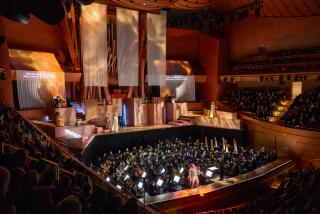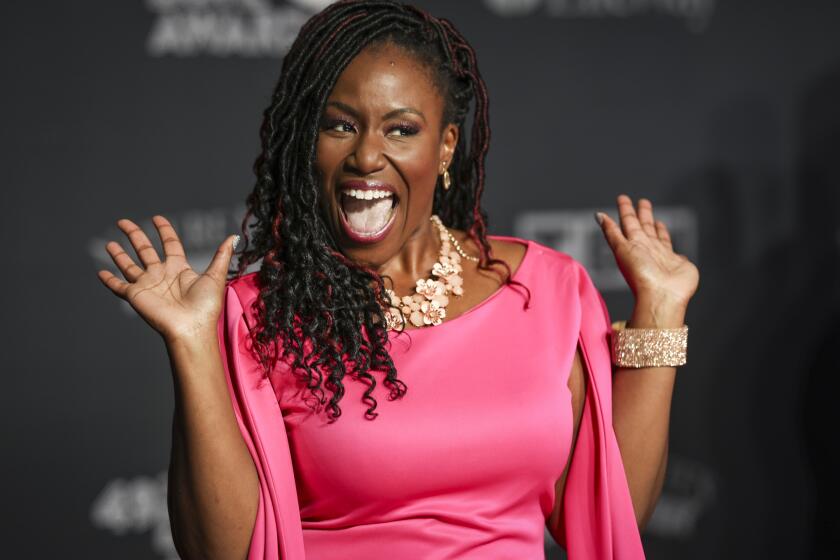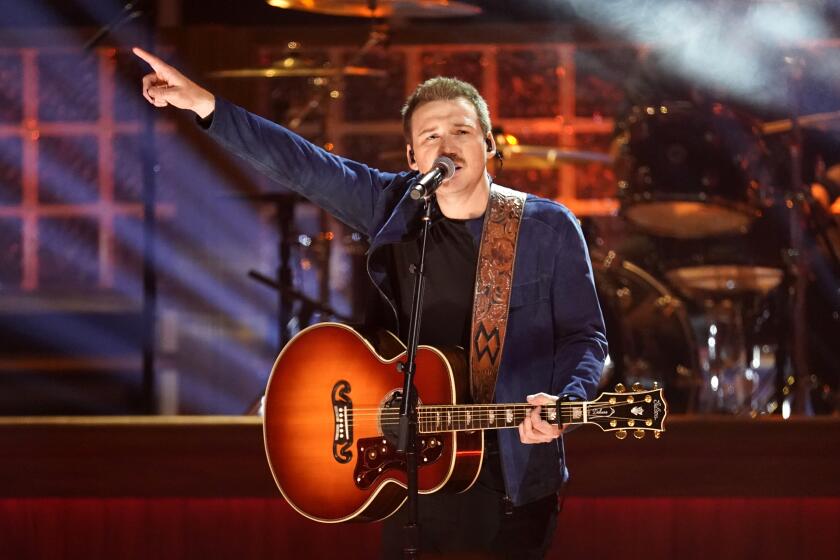In ‘Wildheart,’ Miguel explores L.A.’s ‘weird mix of hope and desperation’
Before hitting play last month to begin a one-on-one listening session of an early mix of his exceptional new album, “Wildheart,” the multi-hyphenate musician Miguel offered a sort of preamble.
The Grammy-winning guitarist, producer, singer and lyricist, born and raised in San Pedro and Inglewood, described his goal of making an album that evoked not only a sound but an atmospheric vibe, a certain quality of light, an essential Southern California energy.
“I wanted it to be rooted in Los Angeles because it’s where I’m from,” said the artist, 29, standing at his laptop in a posh listening room within his management team’s Culver City offices. “I wanted it to feel like twilight, because it’s my favorite time of day. And it’s almost the perfect symbolism for what Los Angeles is.”
A confident artistic breakthrough released during a particularly fruitful period for Los Angeles music, “Wildheart” mixes contemporary soul, electrified R&B, rock and commercial pop, ignoring genre restrictions on the way to creating its own brand of cohesion. He wanted the album, which will be released June 30, “to feel the way that I know my city,” a place he describes as “a weird mix of hope and desperation.”
For instance, Venice Beach, where he’s spent a lot of time. “It’s beautiful — people-watching, you see all these characters, the sun. But at 8:45 or 9 o’clock, the derelicts start coming out, and it becomes a completely different place.”
Thick with more guitar than his previous two records combined, the 13 songs roam the region, driven by a mix of electrified funk and lustful smooth rhythms. Woven through are lyrical themes that document a city alive with pitfalls and possibilities. During “Hollywood Dreams,” he imagines fading stardom while bowing before its most potent symbol: “Sweet Hollywood sign, you’re my salvation.”
The artist born Miguel Jontel Pimentel surfs through barrels literal and figurative on the cowbell-driven “Waves,” seduces with bawdy choruses about having sex “like we’re filming in the Valley.” For “N.W.A” Miguel harnesses the Compton hip-hop group’s moniker to describe a lover with a certain taste in men, then turns the track over to expert rapper Kurupt for a more detailed description.
Permeating it all is a musician who’s been pursuing a life in music since he was a middle-school kid introducing himself to new classmates by singing them a song. The gesture revealed his confidence, but some members of the audience were less impressed. It touched off a few years of bullying at the hands of a posse of popular kids.
Cueing up “What’s Normal Anyway,” he quotes one of the city’s grittiest bards. “Everybody knows the [Charles] Bukowski quote, ‘Find what you love and let it kill you.’ I’m just a firm believer that that’s what life is really all about.” He ups the volume while his recorded voice opens on an adolescence spent straddling cultures: “Too proper for the black kids, too black for the Mexicans, too square to be a hood.... What’s normal anyway?”
Early calling
Determination prevailed, as did the messages he was absorbing from West Coast hip-hop and essential East Coast jams by EPMD and Gang Starr. His black mother, whom he describes as “very religious,” didn’t allow rap music in the house, but his father was more flexible. As such, the son and his brother absorbed the teachings of Funkadelic, Queen, the Rolling Stones, Tom Tom Club and Bob Marley.
“He loved it all,” said Miguel of his father, who is Mexican. “All the other stuff — the soul stuff, jazz, that’s Mom. Which I love. It’s at the core. It’s the roots.”
That the son would be somehow involved in music was never in doubt, said Miguel. “There’s never been any other thing. I’ve done other jobs, but I always knew I was going to be doing this.” That determination, coupled with obvious talent, earned him auditions “in every ... office you could think of,” he recalled. “Name them, they’d seen me and heard me.”
The allure was obvious. A brown-eyed handsome charmer with almond-shaped eyes that glow and a pouf of black hair that he wears in a curly pompadour, Miguel exudes charisma.
But at first it didn’t click. “They were trying to make me more black,” he said, reciting a typical rejection spiel: “‘Even if we think you’re talented, we don’t know what to do with you.’ That’s what it was. It wasn’t hard to see.” What he calls his “pivotal moment” occurred when he was 19. “I finally stopped trying to conform.” He skipped college and immersed himself in songwriting, practicing, producing, working in studios, learning the etiquette and language of the craft.
The more he absorbed, the more he became convinced: “It wasn’t out there, what I wanted to hear. That made me believe that I didn’t have to settle for being a writer.”
Good thing. “Wildheart” is his best, a few levels up from the artist’s trend-chasing debut and his follow-up commercial breakthrough “Kaleidoscope Dream.” The first, released in 2010 after a two-year delay by Jive Records, generated buzz with “Sure Thing” and “All I Want Is You,” the latter of which featured an early appearance by rapper J. Cole.
“Kaleidoscope” was issued by his current label, RCA, in 2012 and transformed his career. Its breakout hit, “Adorn,” a swoon-worthy crush-note that set hearts aflutter, hit the top of Billboard’s R&B/Hip Hop singles chart that fall and earned him a Grammy Award for best R&B song. The clever come-on “How Many Drinks” featured a breakout verse by fellow Angeleno and friend Kendrick Lamar. The album peaked at No. 3 and confirmed Miguel’s commercial potential, but the deeper cuts suggested an artist interested in bypassing the Top 40 dead end.
The time since was spent touring and promoting, a graceful ascent marked by a not-so-graceful improvised stage leap during the 2013 Billboard Music Awards. The accident, for which Miguel has apologized, injured two attendees, one of whom recently filed suit against the artist and the MGM Grand in Las Vegas, where the ceremony was held.
Miguel produced Mariah Carey’s should-have-been smash “Beautiful” and helped deliver hooks (with Rod Stewart) on ASAP Rocky’s “Everyday” and as part of the “Hunger Games: Mockingjay, Part 1” soundtrack (with the Chemical Bros.). He bought a house in Playa del Rey, up the road from Pedro. While settling in and getting into the creative zone, he processed his rise and contemplated the identity of both his city and himself.
His aim was to better reflect and publicly embrace his multi-hyphenate identity, one that baffled decision-makers earlier in his career. “Everybody was like, ‘How do we market him? What is he? Is he Asian and black? But his name is Miguel.’ My curly hair would throw people off too. ‘We don’t get it. He’s black? Asian? Mexican? Look at his hair. What?’”
L.A. identity
A few weeks later after a late-morning photo shoot at the Sunken City, beach-side concrete ruins in San Pedro that have become a teen hangout, Miguel and his entourage loaded into a black Escalade and head to Busy Bee Market, a locally well-known sandwich shop and grocery not far from Terminal Island. While waiting for a sub, the artist sat on a bench espousing Pedro as people around him casually rubber-necked in recognition. “It’s maintained a bit of a small-town vibe, which is awesome,” he said.
He spoke with obvious love for his hometown, a largely working-class transportation hub with a character far removed from the wealthy enclaves nearby. If the Busy Bee visit suggested a newly crowned, newly rich champion revisiting his quaint, rough-and-tumble youth, it was tempered by Miguel’s interactions with a few old friends he ran into while eating on the curb outside. “Say hi to your sister,” he said to one friend.
“All the longshoremen were up the hill,” he said of his neighborhood, which was “closer to where the cruise ships pulled up, right by the bridge.” He recalled a thrift store in Old Town called Cheap that provided the style-conscious young would-be artist with inexpensive fashion. “We didn’t have any money, so I’d go in there and geek out on weird....” The result was a mix-and-match individualism borne of equal parts necessity and creativity. The store’s gone, but Old Town hasn’t changed much, he said.
“I had to pick and choose who I identified with, which contributes to me being the artist that I am. I don’t feel like I need to conform. I’ve been different.” The tension, though, fueled a realization. “I am Los Angeles,” he said. “I’m Mexican and black. As far as I’m concerned, I’m one of the best representations of L.A.” Though Korean, Armenian and Chinese Americans and others might take exception, that idea helped define “Wildheart.”
The artist, who will headline Club Nokia on June 26, recently announced his Wildheart Tour, which will carry him across North America through the summer. It will conclude in grand fashion on the lawn Hollywood Forever Cemetery on Sept. 4.
At his management offices as the final songs played, the artist came upon a kind of conclusion. “Wild hearts are the ones that transcend,” he explained. “They transcend programming, the subconscious ceilings that are placed upon us whether we know it or not. It’s the ones that say ... I’m going to do it. I believe I can.”
“Wildheart” suggests he already has.
Twitter: @LilEdit
More to Read
The biggest entertainment stories
Get our big stories about Hollywood, film, television, music, arts, culture and more right in your inbox as soon as they publish.
You may occasionally receive promotional content from the Los Angeles Times.







